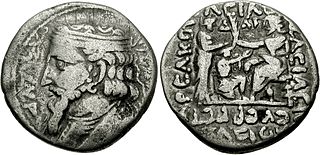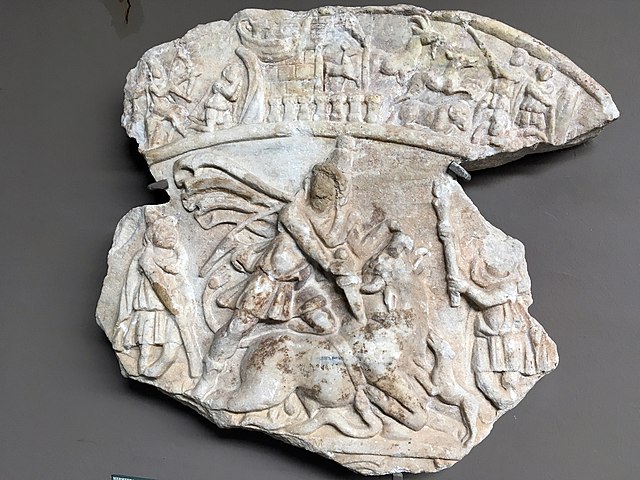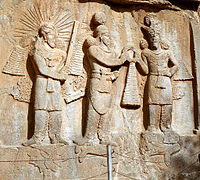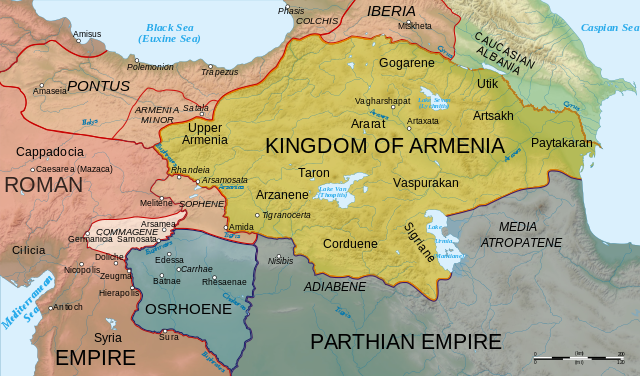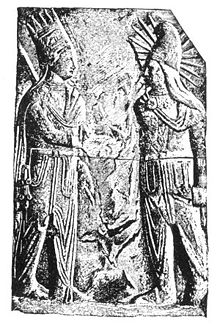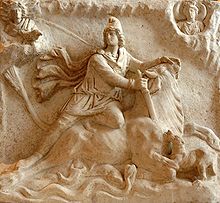
| MITRA / MITHRA Mitra or Mithra is the same word.
Mithra is the Zoroastrian Divinity (yazata) of Covenant, Light, and Oath. In addition to being the divinity of contracts, Mithra is also a judicial figure, an all-seeing protector of Truth, and the guardian of cattle, the harvest, and of the Waters.
The Romans attributed their Mithraic mysteries (the mystery religion known as Mithraism) to "Persian" (i.e. Zoroastrian) sources relating to Mithra. Since the early 1970s, the dominant scholarship has noted dissimilarities between the Persian and Roman traditions, making it, at most, the result of Roman perceptions of (Pseudo-)Zoroastrian ideas.
Etymology :
Together with the Vedic common noun mitra, the Avestan common noun mi?ra derives from Proto-Indo-Iranian *mitrám, from the root *mi- "to bind", with the "tool suffix" -tra- "causing to". Thus, etymologically mitra/mi?ra means "that which causes binding", preserved in the Avestan word for "Covenant, Contract, Oath".
In Middle Iranian languages (Middle Persian, Parthian etc.), mi?ra became mihr, from which New Persian mehr, Wanetsi and Wazirwola (Pashto) mer?/myer, and Armenian mihr/mehr ultimately derive.
In scripture :
Like most other Divinities, Mithra is not mentioned by name in the Gathas, the oldest texts of Zoroastrianism and traditionally attributed to Zoroaster himself, or by name in the Yasna Haptanghaiti, a seven-verse section of the Yasna liturgy that is linguistically as old as the Gathas. As a member of the Iranian ahuric triad, a feature that only Ahura Mazda and Ahura Berezaiti (Apam Napat) also have, Mithra is an exalted figure. Together with Rashnu "Justice" and Sraosha "Obedience", Mithra is one of the three judges at the Chinvat Bridge, the "Bridge of Separation" that all souls must cross. Unlike Sraosha, Mithra is not, however, a psychopomp, a guide of souls to the place of the dead. Should the Good Thoughts, Words and Deeds outweigh the Bad, Sraosha alone conveys the Soul across the Bridge.
As the Divinity of Contract, Mithra is undeceivable, infallible, eternally watchful, and never-resting. Mithra is additionally the protector of cattle, and his stock epithet is "of Wide Pastures." He is Guardian of the waters and ensures that those pastures receive enough of it.
The lack of Mithra's presence in the texts was once a cause of some consternation amongst Iranians. An often repeated speculation of the first half of the 20th century was that the lack of any mention (i.e., Zoroaster's silence) of Mithra in these texts implied that Zoroaster had rejected Mithra. This ex silentio speculation is no longer followed. Building on that speculation was another series of speculations, which postulated that the reason why Zoroaster did not mention Mithra was that the latter was the supreme god of a bloodthirsty group of daeva-worshipers that Zoroaster condemned. However, "no satisfactory evidence has yet been adduced to show that, before Zoroaster, the concept of a supreme god existed among the Iranians, or that among them Mithra – or any other divinity – ever enjoyed a separate cult of his or her own outside either their ancient or their Zoroastrian pantheons."
The Avestan Hymn to Mithra (Yacht 10) is the longest, and one of the best preserved, of the Yashts. Mithra is described in the Zoroastrian Avesta scriptures as "Mithra of Wide Pastures, of the Thousand Ears, and of the Myriad Eyes," (Yandasna 1:3), "the Lofty, and the Everlasting... the Province Ruler,"(Yasna 1:11),"the Yazad (Divinity) of the Spoken Name" (Yasna 3:5), and "the Holy," (Yasna 3:13). The Khorda Avesta (Book of Common Prayer) also refer to Mithra in the Litany to the Sun, "Homage to Mithra of Wide Cattle Pastures," (Khwarshed Niyayesh 5), "Whose Word is True, who is of the Assembly, Who has a Thousand Ears, the Well-Shaped One, Who has Ten Thousand Eyes, the Exalted One, Who has Wide Knowledge, the Helpful One, Who Sleeps Not, the Ever Wakeful. We sacrifice to Mithra, The Lord of all countries, Whom Ahura Mazda created the most glorious, Of the Supernatural Yazads. So may there come to us for Aid, Both Mithra and Ahura, the Two Exalted Ones,"(Khwarshed Niyayesh 6-7), "I shall sacrifice to his mace, well aimed against the Skulls of the Daevas," (Khwarshed Niyayesh 15). Some recent theories have claimed Mithra represents the Sun itself, but the Khorda Avesta refers to the Sun as a separate entity – as it does with the Moon, with which the Sun has "the Best of Friendships," (Khwarshed Niyayesh 15).
In inscriptions :
Although there is no known Mithraic iconography in the Achaemenid period, the deity is invoked in several royal Achaemenid inscriptions :
In Artaxerxes II's (r. 404 - 358 B.C.) trilingual (Old Persian, Elamite and Babylonian) inscription at Susa (A2Sa) and Hamadan (A2Hc), which have the same text, the emperor appeals to "Ahuramazda, Anahita, and Mithra protect me against all evil", and in which he beseeches them to protect what he has built.
Although the Behistun inscription of Darius I (r. 522 - 486 B.C.) invokes Ahuramazda and "the Other Gods who are", this inscription of Artaxerxes II is remarkable as no Achaemenid king before him had invoked any but Ahura Mazda alone by name. Boyce suggests that the reason for this was that Artaxerxes had chosen Anahita and Mithra as his patron/protector Divinities.
Mithra has invoked again in the single known inscription of Artaxerxes III, A3Pa, found at Persepolis. In that inscription, that emperor to appeals to "Ahuramazda and the God Mithra preserve me, my country, and what has been built by me."
In tradition :
Coin of Artabanus II of Parthia (ca. 128-124 BC). The Hellenistic depiction on the reverse shows the king kneeling before an Apollo-like god, which is thought to be Mithra.
A marble relif of Mithra, II-III century AD In the Zoroastrian calendar, the sixteenth day of the month and the seventh month of the year are dedicated to and are under the protection of Mithra. The Iranian civil calendar of 1925 adopted Zoroastrian month-names, and as such also has the seventh month of the year named "Mihr". The position of the sixteenth day and seventh month reflects Mithra's rank in the hierarchy of the Divinities; the sixteenth day and seventh month are respectively the first day of the second half of the month and the first month of the second half of the year. The day on which the day-name and month-name dedications intersect is (like all other such intersections) dedicated to the divinity of that day/month, and is celebrated with a Jashan (from Avestan Yasna, "Worship") in honor of that Divinity. In the case of Mithra, this was Jashan-e Mihragan, or just Mihragan for short.
In Zoroastrian scripture, Mithra is distinct from the divinity of the Sun, Hvare-khshaeta (literally "Radiant Sun", whence also Middle Persian Khorshed for the Sun). However, in Zoroastrian tradition, Mithra evolved from being an all-seeing figure (hence vaguely associated with the Sun) into a divinity co-identified with the Sun itself, effectively taking over Hvare-khshaeta's role. How or when or why this occurred is uncertain, but it is commonly attributed to conflation with Babylonian Shamash and/or Greek Apollo, with whom Mithra shares other characteristics (e.g. a judicial function). This characteristic is part of Mithra's Indo inheritance since the Indic RigVed have solar divinities that are not distinct from Mithra/Mitra, and in the AtharvaVed, Mitra is associated with sunrise, Sun Salutation is a daily yogic activity worldwide even in current times and is preceded by chanting 'OM Mitraya Namaha' as 'Mitraya' is one of the 108 Names for Lord Surya/Sun God.
Royal names incorporating Mithra's (e.g., "Mithradates") appear in the dynasties of Parthia, Armenia, and in Anatolia, in Pontus and Cappadocia.
The youthful Apollonian-type Mithra is found in images from other countries of Iranian culture in the Parthian period, such as Commagene in the Roman-Parthian border and the Kushan Empire on the Indo-Iranian border.
In Manichaeism :
Persian and Parthian-speaking Manichaeans used the name of Mithra current in their time (Mihryazd, q.e. Mithra-yazata) for two different Manichaean angels.
1. The first, called Mihryazd by the Persians, was the "Living Spirit" (Aramaic ruha hayya), a savior-figure who rescues the "First Man" from the demonic Darkness into which he had plunged.
2. The second, known as Mihr or Mihr Yazd among the Parthians, is the "Messenger" (Aramaic izgadda), likewise a savior figure, but one concerned with setting up the structures to liberate the Light lost when the First Man had been defeated.
The second figure mentioned above, the Third Messenger, was the helper and redeemer of mankind, and identified with another Zoroastrian divinity, Narisaf (derived from Pahlavi Narseh from Avestan Nairyo.sa?ho, meaning 'Potent Utterance', the name of a Yazata). Citing Boyce, Sundermann remarks, "It was among the Parthian Manicheans that Mithra as a Sun God surpassed the importance of Narisaf as the common Iranian image of the Third Messenger; among the Parthians the dominance of Mithra was such that his identification with the Third Messenger led to cultic emphasis on the Mithraic traits in the Manichaean God."
Unrelated to these Mihrs are Parthian and Sogdian Mytr or Mytrg. Although sharing linguistic roots with the name Mithra, Werner Sundermann established that those names denote Manicheanisms equivalent of Maitreya.
Mitra / Mithra :
Mitra means God of Sun, Friendship and Energy. It is affiliated with Adityas, Surya and Deva. Its abode is in Suryalok, mount is Chariot. His consort is Ushas, Ratri, Saranyu / Sandhya, Chhaya and his children are Shani, Yami and Yam.
Mitra (Proto-Indo-Iranian: *mitrás) is the name of an Indo-Iranian divinity from which the names and some characteristics of Rigvedic Mitrá and Avestan Mithra derive.
The names (and occasionally also some characteristics) of these two older figures were subsequently also adopted for other figures :
1. A vrddhi-derived form of Sanskrit mitra gives Maitreya, the name of a bodhisattva in Buddhist tradition.
2. In Hellenistic-era Asia Minor, Avestan Mithra was conflated with various local and Greek figures leading to several different variants of Apollo-Helios-Mithras-Hermes-Stilbon.
3. Via Greek and some Anatolian intermediate, the Avestan theonym also gave rise to Latin Mithras, the principal figure of the first century Roman Mysteries of Mithras (also known as 'Mithraism').
4. In Middle Iranian, the Avestan theonym evolved (among other Middle Iranian forms) into Sogdian Miši, Middle Persian and Parthian Mihr, and Bactrian Miuro (/mihru/).[citation needed] Aside from Avestan Mithra, these derivative names were also used for :
a) Greco-Bactrian Mithro, Miiro, Mioro and Miuro;
b)
by the Manichaeans for one of their own deities.
Mythology :
Both Vedic Mitra and Avestan Mithra derive from an Indo-Iranian common noun *mitra-, generally reconstructed to have meant "covenant, treaty, agreement, promise." This meaning is preserved in Avestan mitra "covenant." In Sanskrit and modern Indo-Aryan languages, mitra means "friend," one of the aspects of bonding and alliance.
The Indo-Iranian reconstruction is attributed to Christian Bartholomae, and was subsequently refined by A. Meillet (1907), who suggested derivation from the Proto-Indo-European root *mey- "to exchange."
A suggested alternative derivation was *meh "to measure" (Gray 1929). Pokorny (IEW 1959) refined Meillet's *mei as "to bind." Combining the root *mei with the "tool suffix" -tra- "that which [causes] ..." (also found in man-tra-, "that which causes to think"), then literally means "that which binds," and thus "covenant, treaty, agreement, promise, oath" etc. Pokorny's interpretation also supports "to fasten, strengthen", which may be found in Latin moenia "city wall, fortification", and in an antonymic form, Old English (ge)maere "border, boundary-post".
Meillet and Pokorny's "contract" did however have its detractors. Lentz (1964, 1970) refused to accept abstract "contract" for so exalted a divinity and preferred the more religious "piety." Because present-day Sanskrit mitra means "friend," and New Persian mihr means "love" or "friendship," Gonda (1972, 1973) insisted on a Vedic meaning of "friend, friendship," not "contract".
Meillet's analysis also "rectified earlier interpretations" that suggested that the Indo-Iranian common noun *mitra- had anything to do with the light or the sun. When H. Lommel suggested that such an association was implied in the Younger Avesta (since the 6th century BCE), that too was conclusively dismissed. Today, it is certain that "(al)though Mi?ra is closely associated with the sun in the Avesta, he is not the sun" and "Vedic Mitra is not either."
Old Persian Mitra or Mitra – both only attested in a handful of 4th-century BCE inscriptions of Artaxerxes II and III – "is generally admitted [to be] a borrowing from the Avesta," the genuine Old Persian form being reconstructed as *Miça. (Kent initially suggested Sanskrit but later changed his mind). Middle Iranian myhr (Parthian, also in living Armenian usage) and mihr (Middle Persian), derive from Avestan Mithra.
Greek/Latin "Mithras," the focal deity of the Greco-Roman cult of Mithraism is the nominative form of vocative Mithra. In contrast to the original Avestan meaning of "contract" or "covenant" (and still evident in post-Sassanid Middle Persian texts), the Greco-Roman Mithraists probably thought the name meant "mediator." In Plutarch's 1st-century discussion of dualistic theologies, Isis and Osiris (46.7) the Greek historiographer provides the following explanation of the name in his summary of the Zoroastrian religion: Mithra is a meson ("in the middle") between "the good Horomazdes and the evil Aremanius and this is why the Pérsai call the Mediator Mithra". Zaehner[8] attributes this false etymology to a role that Mithra (and the sun!) played in the now extinct branch of Zoroastrianism known as Zurvanism.
Indian Mitra :
Vedic Mitra is a prominent deity of the RigVed distinguished by a relationship to Varun, the protector of rta. Together with Varun, he counted among the Adityas, a group of solar deities, also in later Vedic texts. Vedic Mitra is the patron divinity of honesty, friendship, contracts and meetings.
The first extant record of Indo-Aryan Mitra, in the form mi-it-ra-, is in the inscribed peace treaty of c. 1400 BC between Hittites and the Hurrian kingdom of the Mitanni in the area southeast of Lake Van in Asia Minor. Mitra appears there together with four other Indic divinities as witnesses and keepers of the pact.
Mitra Vedic :
Mitra (Sanskrit Mitrá) is a divinity of Indic culture, whose function changed with time. In the Mitanni inscription, Mitra is invoked as one of the protectors of treaties. In the RigVed, Mitra appears primarily in the dvandva compound Mitra-Varun, which has essentially the same attributes as Varun alone, e.g. as the principal guardian of "Truth, Order", breaches of which are punished. In the late Vedic texts and the Brahmanas, Mitra is increasingly associated with the light of dawn and the morning sun (while Varun becomes associated with the evening, and ultimately the night). In the post-Vedic texts – in which Mitra practically disappears – Mitra evolved into the patron divinity of friendship, and because he is "friend", abhors all violence, even when sacred.
Proper name :
The Indo-Iranian common noun *mitra means "(that which) causes [-tra] to bind [mi-]", hence Sanskrit mitram, "covenant, contract, oath", the protection of which is Mitra's role in both the RigVed and in the Mitanni treaty. In post-Vedic India, the noun mitra came to be understood as "friend", one of the aspects of bonding and alliance. Accordingly, in post-Vedic India, Mitra became the guardian of friendships. In most Indian languages, the word mitr means friend. The feminine form of the word in languages like Marathi is maitrin.
In the Veds :
In the RigVed, the oldest of the Vedic texts, Mitra is mostly indistinguishable from Varun, together with whom Mitra forms a dvandva pair Mitra-Varun, and in which Mitra-Varun has essentially the same characteristics as Varun alone. Varun is not only the greater of the two, but also – according to RV 2.12 – the second-greatest of the RigVedic gods after Indra. Rigvedic hymns to Mitra-Varun include RV 1.136, 137, 151-153, RV 5.62-72, RV 6.67, RV 7.60-66, RV 8.25 and RV 10.132. Mitra is addressed independently in one hymn only RV 3.59, where he has hardly any traits that distinguish him from Varun, and owing to the scantiness of the information supplied in that hymn his separate character appears somewhat indefinite.
Mitra as an independent personage is insignificant. One theory holds that the dvandvic union possibly represents an apotropaic application [of "friend"] to the otherwise frightening and dangerous Varun."
Combined descriptions :
Mitra-Varuna are conceived as young, they wear glistening garments, are monarchs and guardians of the whole world and their palace is golden, with a thousand pillars and a thousand doors. They support (and are frequently invoked next to) heaven and earth, and the air between heaven and earth. They are lords of rivers and seas, and they send rain and refreshment from the sky.
They wet the pastures with dew of clarified butter (ghee), and rain abounding in heavenly water comes from them. Their domain has streams that flow with honey, and their pastures have cattle that yield refreshment. They afflict those that disregard them with disease. They are asuras, and (like all asuras) wield their power through secret knowledge (maya´), which empowers them to make the sun traverse the sky, and to obscure it with clouds. Their eye is the sun, and they mount their chariot in the highest heavens, which they drive with the rays of the sun as with arms. They have spies that are wise and undeceivable. They are maintainers of order (rtá, “truth”), they are barriers against falsehood, which they punish. They are leaders of the seven Adityas (the celestial sons of Aditi).
Asuras and devas :
In some of their aspects, Varuna is lord of the cosmic rhythm of the sun and other celestial spheres, while Mitra brings forth the light at dawn, which was covered by Varuna the previous evening. Mitra is also independently identified as being force by which the course of the sun is regulated; Savitr (RV 1.35) is identified with Mitra because of those regulations, and Vishnu (RV 1.154) takes his three steps by those regulations. Agni is kindled before dawn to produce Mitra, and when kindled is Mitra.
In the AtharvaVed, Mitra is again associated with sunrise, and is contrasted with Varuna's association with the evening. In the Brahmanas, the exegetical commentaries on the Veds, the associations with morning and evening lead Mitra to be connected with the day, and Varuna with night. Also in Shatapatha Brahmana, Mitra-Varuna is analyzed as "the Counsel and the Power" – Mitra being the priesthood (Purohita), and Varuna the royal power (Rajan).
In inscriptions :
Indic Mitra is first attested in a 14th century BCE Mitanni inscription in which an Indo-Aryan king of Mitanni invokes the gods Mitra, Indra, Varuna, and the Nasatyas as guarantors of his sworn obligations.
In living tradition :
In the AtharvaVed, Mitra is associated with sunrise, and accordingly, Mitra is worshipped in the sunrise prayers of the Hindus. The morning upasthaana prayer, recited to the risen sun after contemplation on the sacred Gayatri mantra, is a collection of Vedic verses addressing Mitra.
Mitra is co-worshipped in the Mitrotsavam Hindu festival of the Sun god Surya, whose orderly traversal of the sky is ensured by Mitra (e.g. RV 1.35) and Mitra-Varuna (e.g. RV 8.25.8).
Mitra is also worship in Bengal in the month of Agrahayan (November- December). It started on Kartik Sankranti or the last day of the Bengali calendar month Kartik and after worshiping of full month the Mitra Dev (locally called Itu Thakur) is abducted into water on the day of Agrahayan Sankranti.
This puja is celebrated like a Vrata especially by the ladies. On first day women are bring a clay pot with full of soil and implant many kind of seeds and plant roots. In every Sunday of the month they worshipped and sprinkle water on it. And on final day they the abducted Itu Thakur in water before sunset.
Iranian Mithra :
Mithra (left) in a 4th-century investiture sculpture at Taq-e Bostan in western Iran In Zoroastrianism, Mithra is a member of the trinity of ahuras, protectors of asha/arta, "truth" or "[that which is] right". Mithra's standard appellation is "of wide pastures" suggesting omnipresence. Mithra is "truth-speaking, with a thousand ears, with ten thousand eyes, high, with full knowledge, strong, sleepless, and ever awake." (Yasht 10.7). As preserver of covenants, Mithra is also protector and keeper of all aspects of interpersonal relationships, such as friendship and love.
Related to his position as protector of truth, Mithra is a judge (ratu), ensuring that individuals who break promises or are not righteous (artavan) are not admitted to paradise. As also in Indo-Iranian tradition, Mithra is associated with (the divinity of) the sun but originally distinct from it. Mithra is closely associated with the feminine yazata Aredvi Sura Anahita, the hypostasis of knowledge.
Mithra in Commagene :
Map showing Commagene (at left in light pink) in 50 AD; nearby are Armenia, Sophene, Osrhoene, and the Roman and Parthian Empires
Mithras-Helios, in Phrygian cap with solar rays, with 1st century BC Antiochus I Theos of Commagene. Found at Mount Nemrut, in present-day eastern Turkey There is a deity Mithra mentioned on monuments in Commagene. According to the archaeologist Maarten Vermaseren, 1st century BC evidence from Commagene demonstrates the "reverence paid to Mithras" but does not refer to "the mysteries". In the colossal statuary erected by King Antiochus I (69–34 BC) at Mount Nemrut, Mithras is shown beardless, wearing a Phrygian cap, and was originally seated on a throne alongside other deities and the king himself. On the back of the thrones there is an inscription in Greek, which includes the name Apollo Mithras Helios in the genitive case. Vermaseren also reports about a Mithras cult in the 3rd century BC. Fayum. R. D. Barnett has argued that the royal seal of King Saussatar of Mitanni from c. 1450 BC. depicts a tauroctonous Mithras.
Buddhist Maitreya :
Maitreya is sometimes represented seated on a throne, and venerated both in Mahayana and non-Mahayana Buddhism. Some have speculated that inspiration for Maitreya may have come from the ancient Iranian deity Mithra. The primary comparison between the two characters appears to be the similarity of their names. According to Tiele (1917) "No one who has studied the Zoroastrian doctrine of the Saoshyants or the coming saviour-prophets can fail to see their resemblance to the future Maitreya."
Paul Williams claims that some Zoroastrian ideas like Saoshyant influenced the beliefs about Maitreya, such as expectations of a heavenly helper, the need to opt for positive righteousness, the future millennium, and universal salvation.[citation needed] Possible objections are that these characteristics are not unique to Zoroastrianism, nor are they necessarily characteristic of the belief in Maitreya.
Graeco-Roman Mithras :
The name Mithra was adopted by the Greeks and Romans as Mithras, chief figure in the mystery religion of Mithraism. At first identified with the Sun-god Helios by the Greeks, the syncretic Mithra-Helios was transformed iSnto the figure Mithras during the 2nd century BC, probably at Pergamon. This new cult was taken to Rome around the 1st century BC and was dispersed throughout the Roman Empire. Popular among the Roman military, Mithraism was spread as far north as Hadrian's Wall and the Germanic Limes. |
